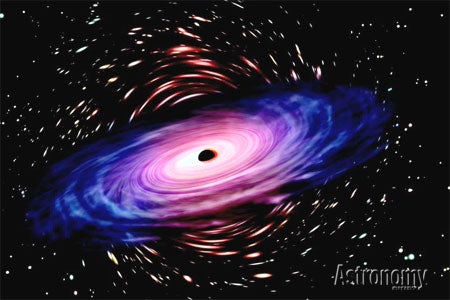Although black holes lie at the frontier of astronomy, the idea such objects might exist stretches back more than 200 years. In the late 1700s, British professor John Michell and French astronomer and mathematician Pierre Simon, Marquis de Laplace, advanced the idea of what Laplace called “dark bodies.” Using Newton’s concepts of light and gravity, they reasoned that the gravitational pull of a massive star could grow large enough to prevent light from escaping. Unfortunately, Newton’s theory could not describe what happens when gravity grows that strong.
Enter Albert Einstein. In 1916, his general theory of relativity put black holes on a firm footing. Using general relativity, which treats gravity as a distortion of space-time, physicists were able to describe black holes in gory detail. A key feature of a black hole is its radius. Scientists call this the “event horizon” because it marks the edge beyond which light cannot escape. Any event taking place inside the event horizon can never be glimpsed from outside. At the center of a black hole lies a point of infinite density called a “singularity.”
General relativity predicted that black holes could exist, but do they? For many decades, scientists didn’t think so — the objects seemed too bizarre to occur in nature. But theorists eventually came to think of them as inevitable. If a star begins life with more than 8 times the Sun’s mass, it will end its life in a titanic explosion known as a supernova. For most such stars, the core is left behind as a neutron star. But in those rare instances when a star starts with more than about 40 solar masses, the core remaining after the supernova is too big to settle down as a neutron star. Instead, it must collapse all the way to a black hole.
Okay, even if black holes exist, how can astronomers find them? After all, they give off no light. Fortunately, black holes don’t always exist in isolation. If one lies near another star or in a gas-rich environment, the black hole’s intense gravity can pull in some of this material. The gas will swirl around the black hole like water circling a drain. As the material moves ever faster, friction heats it to millions of degrees. Gas at this temperature emits lots of X-rays, which Earth-orbiting observatories can detect.
In the 1970s, such observatories discovered X-ray emitting binary star systems. In these systems, a normal star orbits a massive yet invisible companion. One of the best cases known goes by the name Cygnus X-1, because it was the first X-ray source discovered in the constellation Cygnus the Swan. In this illustration, you can see material from a blue supergiant star being drawn toward the black hole. The infalling material forms an accretion disk around the black hole. Most such stellar-sized black holes weigh between 3 and a few dozen times the Sun’s mass. And the event horizon for a 3-solar-mass black hole lies barely 5 miles from the singularity.
But at the centers of most galaxies lurk supermassive black holes weighing millions or even billions of solar masses. These behemoths likely formed early in cosmic history and have grown steadily as they devour surrounding stars and gas clouds. They often betray themselves by the energetic jets powered by this accretion. In this example, a bright bluish jet erupts from the central region of the galaxy M87 in the Virgo cluster.
The proof that supermassive black holes exist comes from studies of gas motions at the centers of galaxies. In this spectrum of the Virgo cluster galaxy M84, gas moves rapidly toward Earth (the blueshift at left) on one side and rapidly away (the redshift at right on the other. The motion of nearly 1 million miles per hour confirms the central black hole weighs at least 300 million solar masses. The event horizon for a black hole of this size is about 500 million miles — or about the radius of Jupiter’s orbit around the Sun.
And that’s our introduction to black holes. We’ll return with another installment of Astronomy 101 in a few months.
Expand your knowledge at Astronomy.com
Check out the complete Astronomy 101 series
Learn about our stellar neighborhood with the Tour the Solar System series
Read about the latest astronomy news










